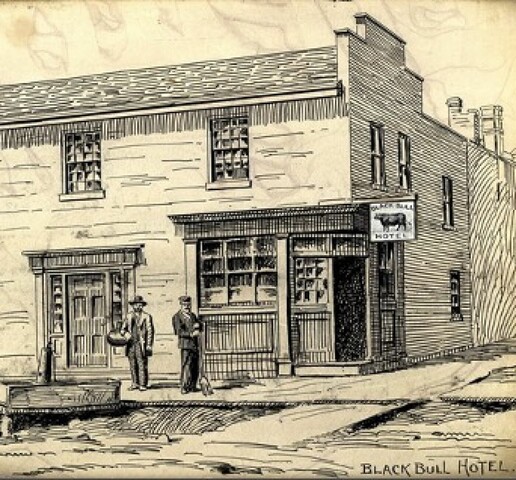
Good Eats: Black Bull & Peter Pan
The Black Bull Tavern
Illustration of the Black Bull Hotel, Queen Street West, 1908. Featured in J. Ross Robertson’s “Landmarks of Toronto.” 3rd series.
The Clifton House, Queen and Soho Streets, ca. 1972. Photographer Unknown. City of Toronto Archives, Fonds 2032, Series 841, File 48, Item 26
Peter Pan Lunch, Queen and Peter Streets. 1972. City of Toronto Archives, Fonds 2032, Series 841, File 48, Item 29.
Exterior of Peter Pan Bistro, Queen Street West, Toronto.
The Black Bull Tavern
Taverns were among the first businesses in the city where residents could enjoy food and drink outside the home. Taverns, also known as public houses or pubs, often provided several services: although selling pints of beer was a tavern keeper’s major task, many taverns also served simple meals. In the late eighteenth and early nineteenth century, taverns also had a role in providing public meeting spaces. Taverns were common spaces to watch local political speeches or debates; they also hosted local social organizations and even provided musical entertainment.
One of Toronto’s oldest taverns
The Black Bull is among the oldest taverns still in operation in Toronto. Opened in the mid-1830s, the tavern was located on what was known as Lot Street (today’s Queen Street). Situated close to what were once the western city limits, the Black Bull opened its doors to provide ales and meals to both travellers and farmers bringing livestock to the city markets. The Black Bull’s owners may have brewed their own beer, but may also have sold ales from John Farr’s brewery (opened in 1817) or Robert Henderson’s brewery on Sherbourne and Richmond Streets (opened in 1809).
Initially a modest wooden structure with a tavern on the ground floor and an inn, known as the Drover’s House, on the second storey, the Black Bull was renovated in the mid-nineteenth century, becoming a solid three-storey brick building with a mansard roof. The Black Bull became a fixture on Queen Street West, renting rooms and pouring pints for generations of Torontonians.
In the early twentieth century, a change in ownership meant a new name for the Black Bull. Rebranded as the Hotel Clifton and subsequently the Clifton House, the tavern owners installed televisions in its main room to attract sports fans to its bar. By the 1970s, the Clifton House name was abandoned and the original Black Bull name was restored to the property. In the 1980s, retired CFL football players Bobby Taylor and Jimmy Hughes (1934–2004) purchased the Black Bull and served as the tavern’s owners and managers for many years. Today, the Black Bull continues an almost two-hundred-year tradition on Queen Street West.
Peter Pan Lunch
Although taverns and hotels were among the first to offer the chance to enjoy a meal outside the home in Toronto, restaurants became more familiar sights on city streets in the early twentieth century. Around 1910, W. Thomas McMahon opened a restaurant on the southeast corner of Queen and Peter Streets, almost directly across the street from the Black Bull Tavern. Taking over from what had been a bicycle shop, the restaurant operated as the Savoy Cafe until 1940 when it became Peter Pan Lunch. Although many looked to J.M. Barrie and Neverland as inspiration behind the name change, the new owner insisted the name simply referred to the nearby Peter Street.
A greasy spoon legacy on Queen Street
Peter Pan Lunch was open for over twenty years, serving countless affordable meals to Torontonians. One beloved menu item was an onion sandwich, which originally cost a daring diner 15 cents. Although rarely seen today, onion sandwiches were popular in the early and mid-twentieth century: the sandwich usually contained sliced, raw onions, served on buttered bread, often accompanied with mayonnaise.
In 1974, the restaurant changed hands: purchased by local and respected restaurateurs Sandy Stagg, Larry Guest, and Mary Jackman. After a two-year renovation, Peter Pan Lunch reopened with a new menu featuring milkshakes, chicken chasseur, and clam chowder.
The new Peter Pan restaurant (“Lunch” was dropped from its name by 1978) became a staple of the Queen Street West dining scene; its kitchen attracted local chefs eager to make a name for themselves, including a young Susur Lee, future owner and celebrity chef of Lee Restaurant on King Street West. The restaurant changed hands again in 2014; new owner and chef Noah Goldberg and his wife bought the building, re-opening the location as the Peter Pan Bistro, which today features a back patio and upstairs events space.
Sources
Jordan St. John, Lost Breweries of Toronto. Toronto: Dundurn Press, 2014.

